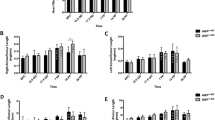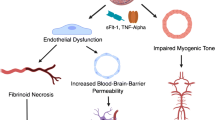Abstract
The maternal system is challenged with many physiological changes throughout pregnancy to prepare the body to meet the metabolic needs of the fetus and for delivery. Many pregnancies, however, are faced with pathological stressors or complications that significantly impact maternal health. A shift in this paradigm is now beginning to investigate the implication of pregnancy complications on the fetus and their continued influence on offspring disease risk into adulthood. In this investigation, we sought to determine whether maternal hypertension during pregnancy alters the cerebral response of adult offspring to acute ischemic stroke. Atrial natriuretic peptide gene-disrupted (ANP−/−) mothers exhibit chronic hypertension that escalates during pregnancy. Through comparison of heterozygote offspring born from either normotensive (ANP+/−WT) or hypertensive (ANP+/−KO) mothers, we have demonstrated that offspring exposed to maternal hypertension exhibit larger cerebral infarct volumes following middle cerebral artery occlusion. Observation of equal baseline cardiovascular measures, cerebrovascular structure, and cerebral blood volumes between heterozygote offspring suggests no added influences on offspring that would contribute to adverse cerebral response post-stroke. Cerebral mRNA expression of endothelin and nitric oxide synthase vasoactive systems demonstrated up-regulation of Et-1 and Nos3 in ANP+/−KO mice and thus an enhanced acute vascular response compared to ANP+/−WT counterparts. Gene expression of Na+/K+ ATPase channel isoforms, Atp1a1, Atp1a3, and Atp1b1, displayed no significant differences. These investigations are the first to demonstrate a fetal programming effect between maternal hypertension and adult offspring stroke outcome. Further mechanistic studies are required to complement epidemiological evidence of this phenomenon in the literature.






Similar content being viewed by others
References
Barker DJP, Osmond C, Winter PD, Winter PD, Margetts B, Simmonds SJ (1989) Weight in infancy and death from ischaemic heart disease. Lancet 334:577–580
Barker DJ, Osmond C, Golding J, Kuh D, Wadsworth ME (1989) Growth in utero, blood pressure in childhood and adult life, and mortality from cardiovascular disease. BMJ 298:564–567
Smith GN, Walker MC, Liu A, Wen SW, Swansburg M et al (2009) A history of preeclampsia identifies women who have underlying cardiovascular risk factors. Am J Obstet Gynecol 200:58.e1–58.e8
Kajantie E, Eriksson JG, Osmond C, Thornburg K, Barker DJP (2009) Pre-eclampsia is associated with increased risk of stroke in the adult offspring: the Helsinki birth cohort study. Stroke 40:1176–1180. doi:10.1161/STROKEAHA.108.538025
Wilson BJ, Watson MS, Prescott GJ, Sunderland S, Campbell DM et al (2003) Hypertensive diseases of pregnancy and risk of hypertension and stroke in later life: results from cohort study. BMJ 326:845. doi:10.1136/bmj.326.7394.845
John SW, Krege JH, Oliver PM, Hagaman JR, Hodgin JB et al (1995) Genetic decreases in atrial natriuretic peptide and salt-sensitive hypertension. Science 267:679–681
de Bold AJ (1985) Atrial natriuretic factor: a hormone produced by the heart. Science 230:767–770
Hamet P, Tremblay J, Pang SC, Garcia R, Thibault G et al (1984) Effect of native and synthetic atrial natriuretic factor on cyclic GMP. Biochem Biophys Res Commun 123:515–527. doi:10.1016/0006-291X(84)90260-2
Waldman SA, Rapoport RM, Murad F (1984) Atrial natriuretic factor selectively activates particulate guanylate cyclase and elevates cyclic GMP in rat tissues. J Biol Chem 259:14332–14334
Tremblay J, Gerzer R, Vinay P, Pang SC, Béliveau R et al (1985) The increase of cGMP by atrial natriuretic factor correlates with the distribution of particulate guanylate cyclase. FEBS Lett 181:17–22
Rubattu S, Bigatti G, Evangelista A, Lanzani C, Stanzione R et al (2006) Association of atrial natriuretic peptide and type A natriuretic peptide receptor gene polymorphisms with left ventricular mass in human essential hypertension. J Am Coll Cardiol 48:499–505. doi:10.1016/j.jacc.2005.12.081
Newton-Cheh C, Larson MG, Vasan RS, Levy D, Bloch KD et al (2009) Association of common variants in NPPA and NPPB with circulating natriuretic peptides and blood pressure. Nat Genet 41:348–353. doi:10.1038/ng.328
Ellis KL, Newton-Cheh C, Wang TJ, Frampton CM, Doughty RN et al (2011) Association of genetic variation in the natriuretic peptide system with cardiovascular outcomes. J Mol Cell Cardiol 50:695–701. doi:10.1016/j.yjmcc.2011.01.010
Rubattu S, Ridker P, Stampfer MJ, Volpe M, Hennekens CH et al (1999) The gene encoding atrial natriuretic peptide and the risk of human stroke. Circulation 100:1722–1726. doi:10.1161/01.CIR.100.16.1722
Feng JA, Perry G, Mori T, Hayashi T, Oparil S et al (2003) Pressure-independent enhancement of cardiac hypertrophy in atrial natriuretic peptide-deficient mice. Clin Exp Pharmacol Physiol 30:343–349
Armstrong DWJ, Tse MY, O’Tierney-Ginn PF, Wong PG, Ventura NM et al (2013) Gestational hypertension in atrial natriuretic peptide knockout mice and the developmental origins of salt-sensitivity and cardiac hypertrophy. Regul Pept 186C:108–115. doi:10.1016/j.regpep.2013.08.006
Armstrong DWJ, Tse MY, Wong PG, Ventura NM, Meens JA et al (2014) Gestational hypertension and the developmental origins of cardiac hypertrophy and diastolic dysfunction. Mol Cell Biochem 391:201–209. doi:10.1007/s11010-014-2003-9
Gargano JW, Reeves MJ, Reeves MJ (2007) Sex differences in stroke recovery and stroke-specific quality of life: results from a statewide stroke registry. Stroke 38:2541–2548. doi:10.1161/STROKEAHA.107.485482
Petrea RE, Beiser AS, Seshadri S, Kelly-Hayes M, Kase CS et al (2009) Gender differences in stroke incidence and poststroke disability in the Framingham heart study. Stroke 40:1032–1037. doi:10.1161/STROKEAHA.108.542894
Angelis E, Tse MY, Pang SC (2005) Interactions between atrial natriuretic peptide and the renin-angiotensin system during salt-sensitivity exhibited by the proANP gene-disrupted mouse. Mol Cell Biochem 276:121–131
Longa EZ, Weinstein PR, Carlson S, Cummins R (1989) Reversible middle cerebral artery occlusion without craniectomy in rats. Stroke 20:84–91
Barber PA, Hoyte L, Colbourne F, Buchan AM (2004) Temperature-regulated model of focal ischemia in the mouse: a study with histopathological and behavioral outcomes. Stroke 35:1720–1725. doi:10.1161/01.STR.0000129653.22241.d7
Ventura NM, Peterson NT, Tse MY, Andrew RD, Pang SC et al (2015) Molecular adaptations in vasoactive systems during acute stroke in salt-induced hypertension. Mol Cell Biochem 399:39–47. doi:10.1007/s11010-014-2230-0
Swanson RAR, Morton MTM, Tsao-Wu GG, Savalos RAR, Davidson CC et al (1990) A semiautomated method for measuring brain infarct volume. J Cereb Blood Flow Metab 10:290–293. doi:10.1038/jcbfm.1990.47
Chang G-Q, Gaysinskaya V, Karatayev O, Leibowitz SF (2008) Maternal high-fat diet and fetal programming: increased proliferation of hypothalamic peptide-producing neurons that increase risk for overeating and obesity. J Neurosci 28:12107–12119. doi:10.1523/JNEUROSCI.2642-08.2008
Oken E, Gillman MW (2003) Fetal origins of obesity. Obesity 11:496–506. doi:10.1038/oby.2003.69
Breier BH, Vickers MH, Ikenasio BA, Chan KY, Wong WP (2001) Fetal programming of appetite and obesity. Mol Cell Endocrinol 185:73–79
Portha B, Chavey A, Movassat J (2011) Early-life origins of type 2 diabetes: fetal programming of the beta-cell mass. Exp Diabetes Res 2011:1–16. doi:10.1155/2011/105076
Stamler JJ, Rose GG, Stamler RR, Elliott PP, Dyer AA et al (1989) INTERSALT study findings. Public health and medical care implications. Hypertension 14(5):570–577. http://eutils.ncbi.nlm.nih.gov/entrez/eutils/elink.fcgi?dbfrom=pubmed&id=2807518&retmode=ref&cmd=prlinks
Devereux RB, Wachtell K, Gerdts E, Boman K, Nieminen MS et al (2004) Prognostic significance of left ventricular mass change during treatment of hypertension. JAMA 292:2350–2356. doi:10.1001/jama.292.19.2350
Okin PM, Devereux RB, Jern S, Kjeldsen SE, Julius S et al (2004) Regression of electrocardiographic left ventricular hypertrophy during antihypertensive treatment and the prediction of major cardiovascular events. JAMA 292:2343–2349. doi:10.1001/jama.292.19.2343
Koren MJ, Devereux RB, Casale PN, Savage DD, Laragh JH (1991) Relation of left ventricular mass and geometry to morbidity and mortality in uncomplicated essential hypertension. Ann Intern Med 114:345–352
Sorensen AG, Copen WA, Østergaard L, Buonanno FS, Gonzalez RG et al (1999) Hyperacute stroke: simultaneous measurement of relative cerebral blood volume, relative cerebral blood flow, and mean tissue transit time. Radiology 210:519–527. doi:10.1148/radiology.210.2.r99fe06519
Derdeyn CP, Videen TO, Yundt KD, Fritsch SM, Carpenter DA et al (2002) Variability of cerebral blood volume and oxygen extraction: stages of cerebral haemodynamic impairment revisited. Brain 125:595–607
Prabhu SS, Broaddus WC, Oveissi C, Berr SS, Gillies GT (2000) Determination of intracranial tumor volumes in a rodent brain using magnetic resonance imaging, Evans blue, and histology: a comparative study. IEEE Trans Biomed Eng 47:259–265. doi:10.1109/10.821776
Fagan SC, Hess DC, Hohnadel EJ, Pollock DM, Ergul A (2004) Targets for vascular protection after acute ischemic stroke. Stroke 35:2220–2225. doi:10.1161/01.STR.0000138023.60272.9e
Ziv II, Fleminger GG, Djaldetti RR, Achiron AA, Melamed EE et al (1992) Increased plasma endothelin-1 in acute ischemic stroke. Stroke 23:1014–1016
Alioglu Z, Orem A, Bulbul I, Boz C, Ozmenoglu M et al (2013) Evaluation of plasma endothelin-1 levels in patients with cerebral infarction. Angiology 53:77–82
Matsuo Y, Si M, Ninomiya M, Fujimoto M (2001) Protective effect of endothelin type A receptor antagonist on brain edema and injury after transient middle cerebral artery occlusion in rats. Stroke 32:2143–2148. doi:10.1161/hs0901.94259
Macrae IM, Robinson MJ, Graham DI, Reid JL, McCulloch J (1993) Endothelin-1-induced reductions in cerebral blood flow: dose dependency, time course, and neuropathological consequences. J Cereb Blood Flow Metab 13:276–284
Endres M, Laufs U, Liao JK, Moskowitz MA (2004) Targeting eNOS for stroke protection. Trends Neurosci 27:283–289. doi:10.1016/j.tins.2004.03.009
Huang Z, Huang PL, Ma J, Meng W, Ayata C et al (1996) Enlarged infarcts in endothelial nitric oxide synthase knockout mice are attenuated by nitro-l-arginine. J Cereb Blood Flow Metab 16:981–987. doi:10.1097/00004647-199609000-00023
Sun M, Zhao Y, Gu Y, Xu C (2009) Inhibition of nNOS reduces ischemic cell death through down-regulating calpain and caspase-3 after experimental stroke. Neurochem Int 54:339–346. doi:10.1016/j.neuint.2008.12.017
Gürsoy-Ozdemir Y, Bolay H, Saribaş O, Dalkara T (2000) Role of endothelial nitric oxide generation and peroxynitrite formation in reperfusion injury after focal cerebral ischemia. Stroke 31:1974–1981
Eliasson MJ, Huang Z, Ferrante RJ, Sasamata M, Molliver ME et al (1999) Neuronal nitric oxide synthase activation and peroxynitrite formation in ischemic stroke linked to neural damage. J Neurosci 19:5910–5918
Kontos CD, Wei EP, Williams JI, Kontos HA, Povlishock JT (1992) Cytochemical detection of superoxide in cerebral inflammation and ischemia in vivo. Am J Physiol 263:H1234–H1242
Kontos HA (2001) Oxygen radicals in cerebral ischemia: the 2001 Willis lecture. Stroke 32:2712–2716
Skou JC (1964) Enzymatic aspects of active linked transport of Na+ and K+ through the cell membrane. Prog Biophys Mol Biol 14:131–166. doi:10.1016/S0079-6107(64)80005-5
Dostanic-Larson I (2005) Physiological role of the 1- and 2-isoforms of the Na+-K+-ATPase and biological significance of their cardiac glycoside binding site. AJP: regulatory. Integr Comp Physiol 290:R524–R528. doi:10.1152/ajpregu.00838.2005
Moseley AE, Williams MT, Schaefer TL, Bohanan CS, Neumann JC et al (2007) Deficiency in Na, K-ATPase α isoform genes alters spatial learning, motor activity, and anxiety in mice. J Neurosci 27:616–626
Vrbjar N, Dzurba A, Ziegelhöffer A (1994) Enzyme kinetics and the activation energy of (Na, K)-ATPase in ischaemic hearts: influence of the duration of ischaemia. Gen Physiol Biophys 13:405–411
Rosenberger C, Rosen S, Shina A, Bernhardt W, Wiesener MS et al (2006) Hypoxia-inducible factors and tubular cell survival in isolated perfused kidneys. Kidney Int 70:60–70. doi:10.1038/sj.ki.5000395
Nagafuji T, Koide T, Takato M (1992) Neurochemical correlates of selective neuronal loss following cerebral ischemia: role of decreased Na+, K(+)-ATPase activity. Brain Res 571:265–271
Acknowledgments
The authors would like to thank Mrs. Judy Janzen-Pang for her expert technical support. NMV is a recipient of the Franklin Bracken Student Fellowship. Financial support of this research was kindly provided by the Heart and Stroke Foundation of Canada (SCP: Grant #: T-6140 and RDA: Grant #: G-14-0006260). Research equipment funding (real-time PCR) was provided by the Canada Foundation of Innovation (CFI). The use of the confocal microscopy facilities at the Queen’s University Cancer Research Centre was gratefully acknowledged.
Author information
Authors and Affiliations
Corresponding authors
Electronic supplementary material
Below is the link to the electronic supplementary material.
Rights and permissions
About this article
Cite this article
Ventura, N.M., Jin, A.Y., Tse, M.Y. et al. Maternal hypertension programs increased cerebral tissue damage following stroke in adult offspring. Mol Cell Biochem 408, 223–233 (2015). https://doi.org/10.1007/s11010-015-2498-8
Received:
Accepted:
Published:
Issue Date:
DOI: https://doi.org/10.1007/s11010-015-2498-8




